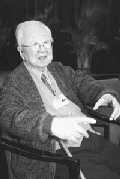|
|||||||||||||||
 |
|
|
|
|
|
|
|
|
|
|
|
|
|
|
|
|
|
|
|
|
|
|
|
|
|
|
|
|
|
|
|
|
|
| Institutions/Troupes > Artists > Painters | กก |
|
The Legacy of Qi Gong: China's Living National Treasure
To own a piece of calligraphy by Qi -- now 90 years old -- is the ambition of many of his admirers, particularly sharp-eyed experts and other enthusiasts. A few years ago, in an effort to deter the endless stream of visitors asking for examples of Qi's calligraphy, authorities from the Beijing Normal University reportedly had to post an official notice on his door declaring: "Mr Qi Gong is ill." Visitors had interrupted the day-to-day life and work of the old man -- a professor of the Chinese language and literature at the university.
Also known as Aisin-Gioro, Qi was born into a Manchu family in Beijing in 1912. His childhood was haunted by memories of a declining aristocrat family following the collapse of the Qing Dynasty (1644-1911).
One year after Qi was born his father had passed away and the boy was brought up by his grandfather, mother and aunt. At age 10, Qi's grandfather died and the family fell into extreme poverty, forcing him to drop out of middle school. But the harsh reality did not get in the way of the young man's burning ambition to pursue his love of art and knowledge. Qi developed a strong interest in painting and classical Chinese literature and became a private student of Beijing scholars and painters Dai Suizhi, Jia Ximin and Wu Jingding. It was also at that time that Qi began to frequent the Palace Museum, becoming an art connoisseur. To support his family and buy books, he often had to sell his paintings and work as a tutor.
Qi was better
known as a painter than a calligrapher in his early years. In the 1930s, his
signature style in Chinese ink painting already begun to mature. Qi was
especially skilled in painting landscapes, bamboo and rocks. Primarily
influenced by traditional literati paintings, his early works displayed an
exceptional understanding of images, colors and brushwork.
"My desire to learn calligraphy was stimulated by a small incident when I was young, recalled Qi. One day, a relative of mine asked me for a painting, but he would not let me add a colophon on it because he disliked my poor calligraphy: 'I will ask your teacher to do it,' he told me. Feeling a sense of shame, I have ever since worked hard to practice calligraphy."
Since the early 1950s, as a busy college teacher, Qi spent most of his spare time on calligraphy and nearly abandoned painting, which was more time-consuming. It was not until the 1980s that he again picked up a paintbrush.
According to Fan Yi, the assistant director of the Oriental Art Gallery, Qi's later paintings and calligraphy match very well and are characterized by the delicacy, elegance and cleanness reminiscent of the traditional Chinese literati. "His art is a result of his profound knowledge as a scholar coupled with the creative, hard work of a true artist," said Fan Yi.
It is true that Qi is more famous as an artist. From 1981, Qi was vice-chairman and later chairman of the Chinese Calligraphers' Association. An outstanding connoisseur of Chinese calligraphy and painting, Qi has also served as Director of the National Relics Evaluation Committee. With other experts, he has appraised many precious relics from museums nationwide.
What Qi values most is his work as a teacher, for which he is deeply indebted to his mentor, Chen Yuan (1880-1971); Chen led Qi towards a life-long career as a teacher and scholar.
In his early 30s, Qi had established himself as an excellent artist and became an accomplished scholar in his 50s when he began publishing a series of influential books on the Chinese language, literature and art. A professor of the classical Chinese language and literature, Qi also served as an advisor to post-graduate students since the early 1980s. Currently, he still tutors six PhD students and eight others working towards their Master's degrees.
At the age of 90, Qi enjoys a healthy and happy life. Occasionally he still writes, paints and lectures. Since his wife Zhang Baochen passed away in 1975, Qi has lived alone in his home and studio on the university campus. The couple had no children.
Qi, who once
joked that he looked like a giant panda, is a living, national treasure to
admirers of his art, knowledge and personality. |
||
| |
||
| Constructed
by Chinadaily.com.cn Copyright © 2003 Ministry of Culture, P.R.China. All rights reserved |
||
 |
